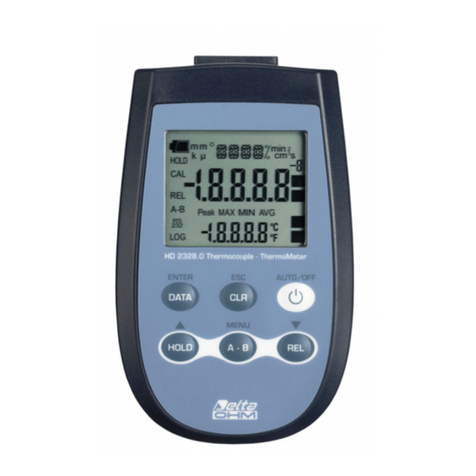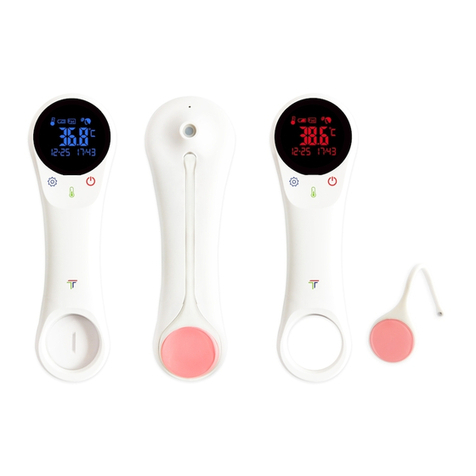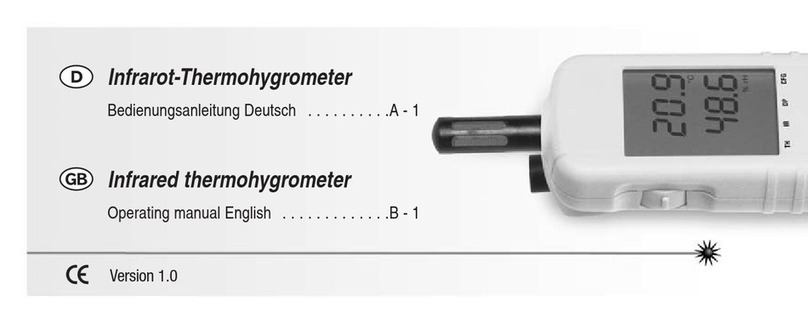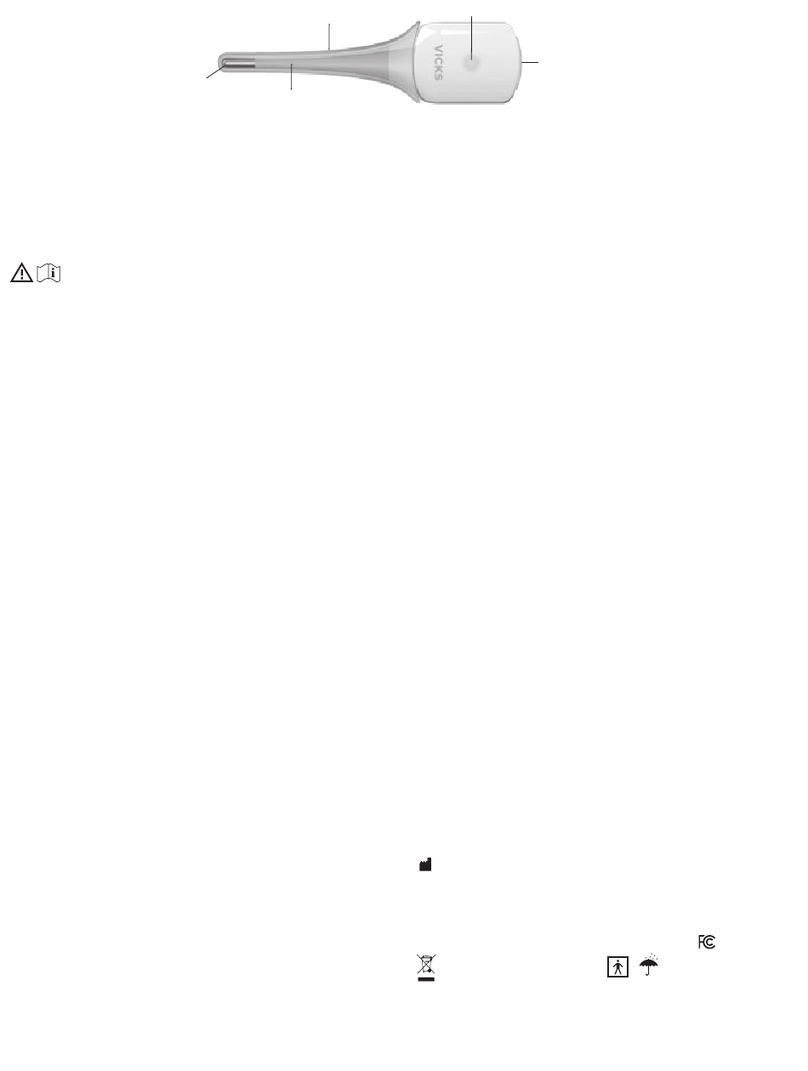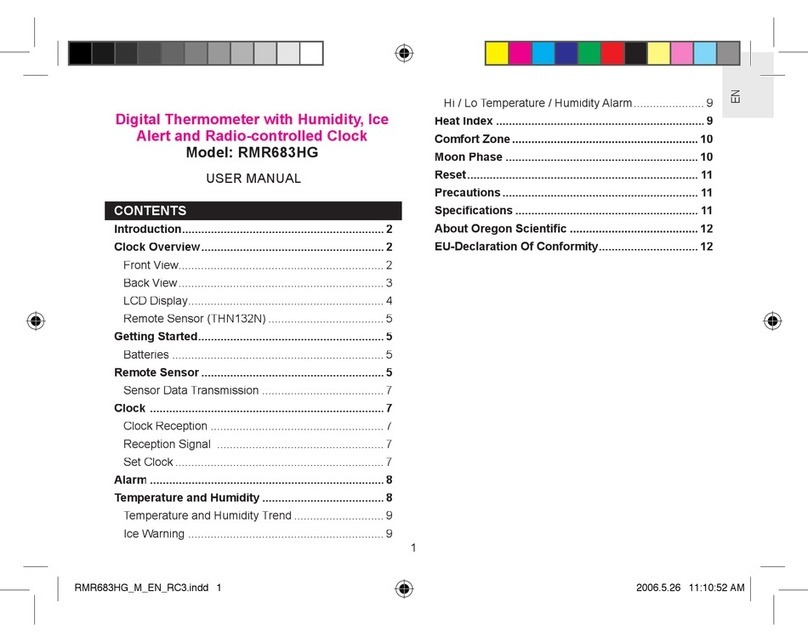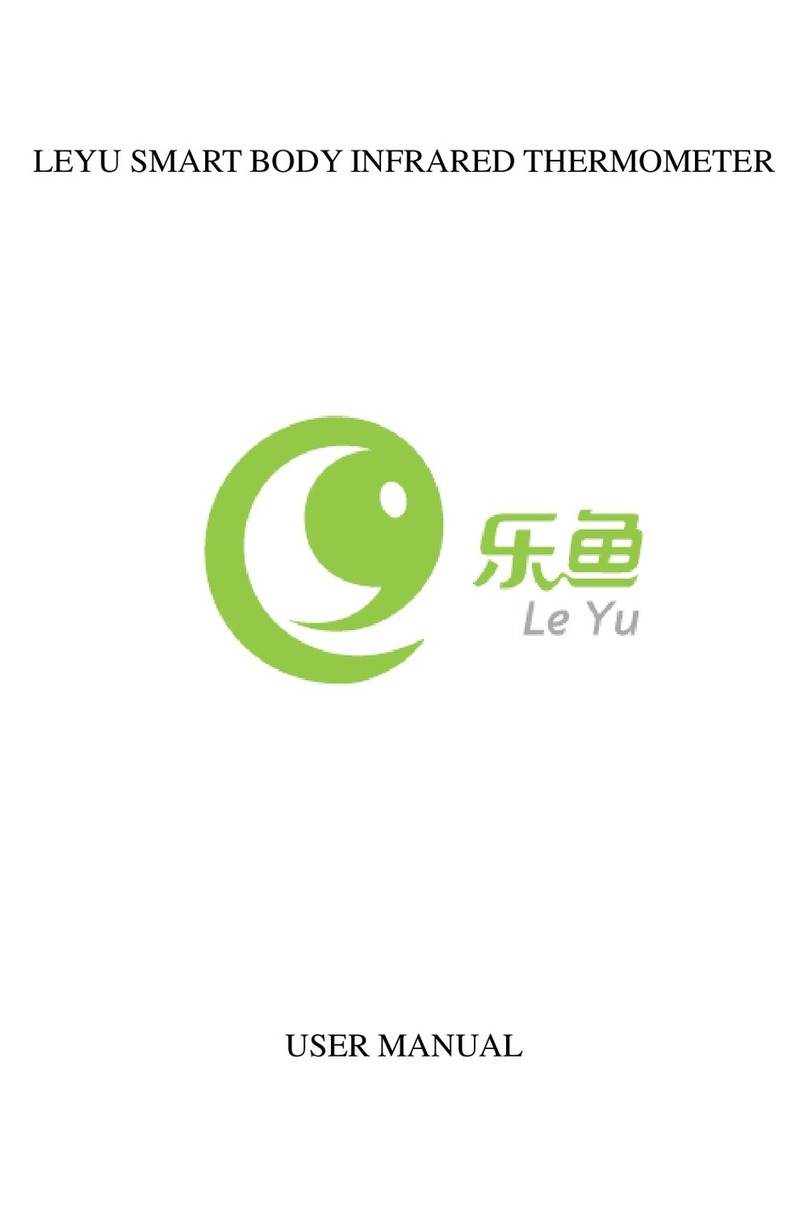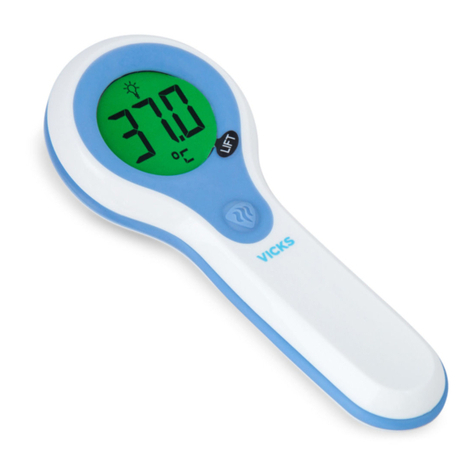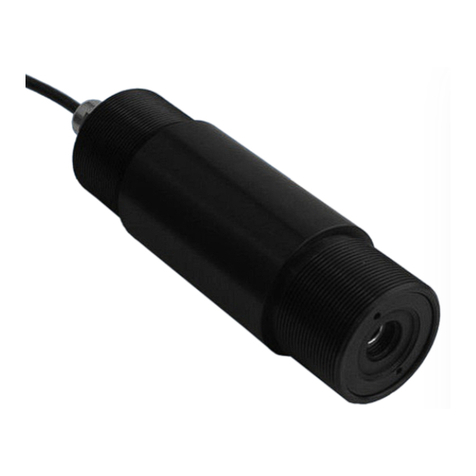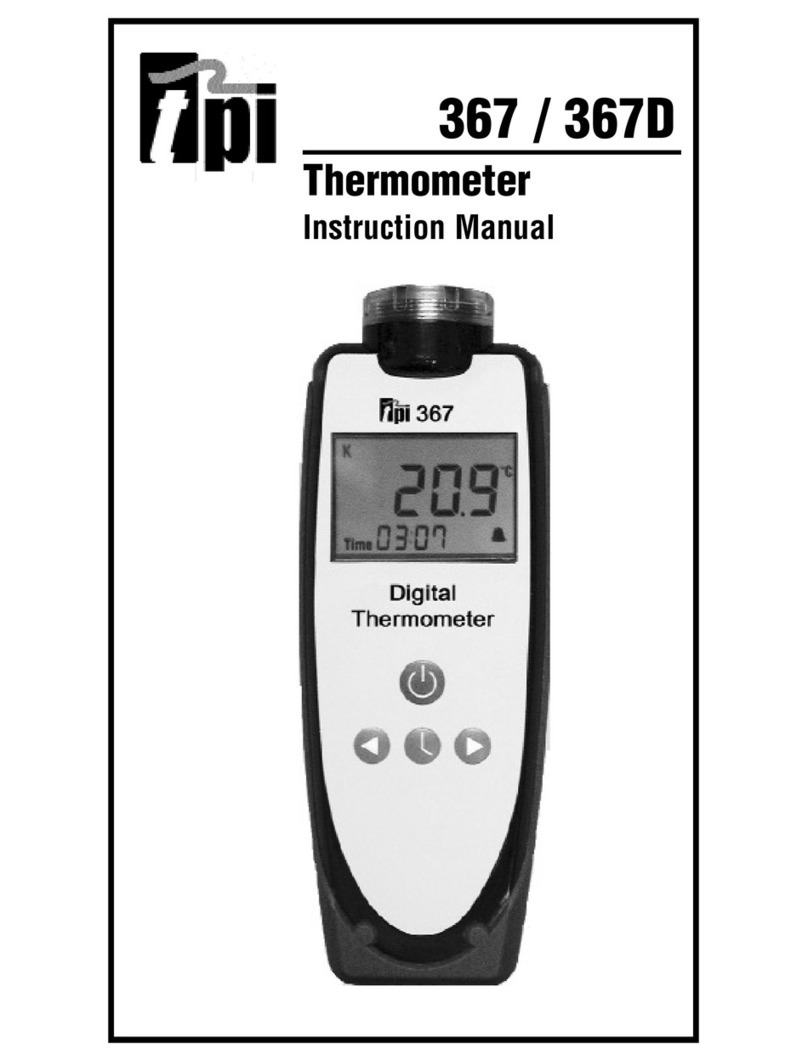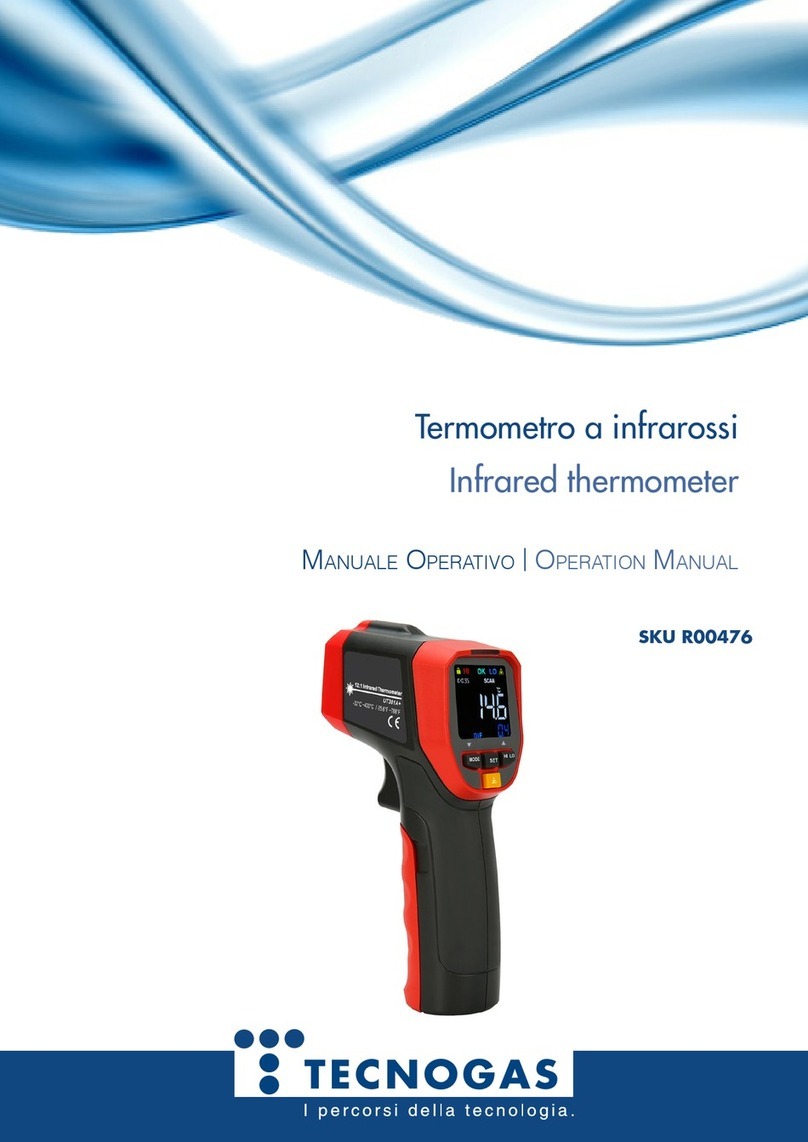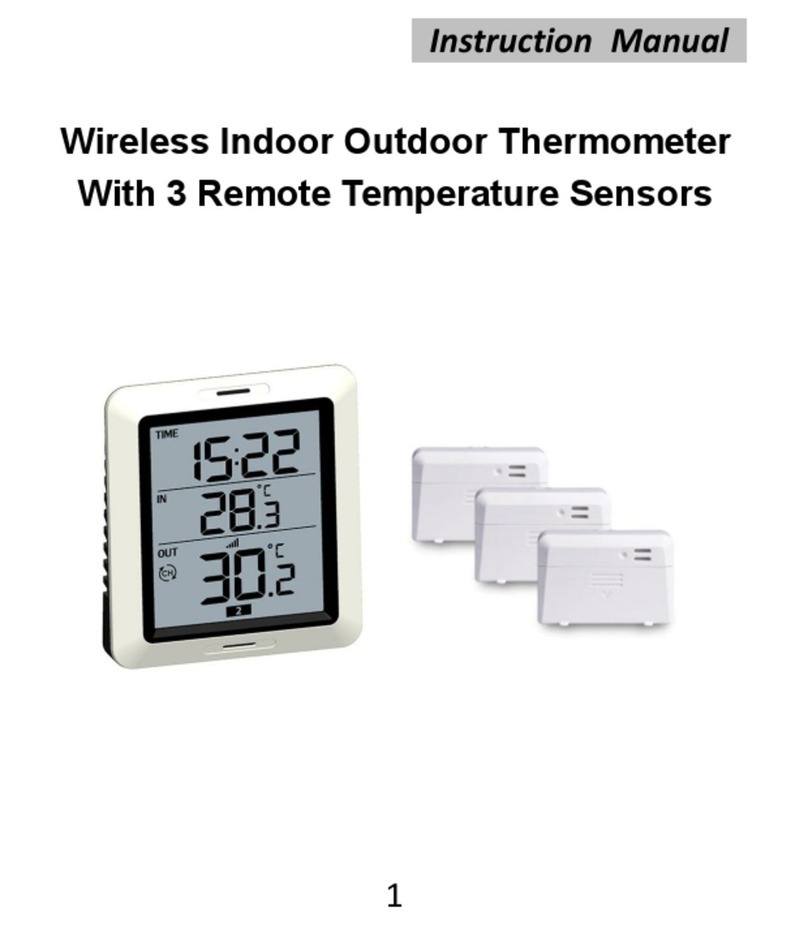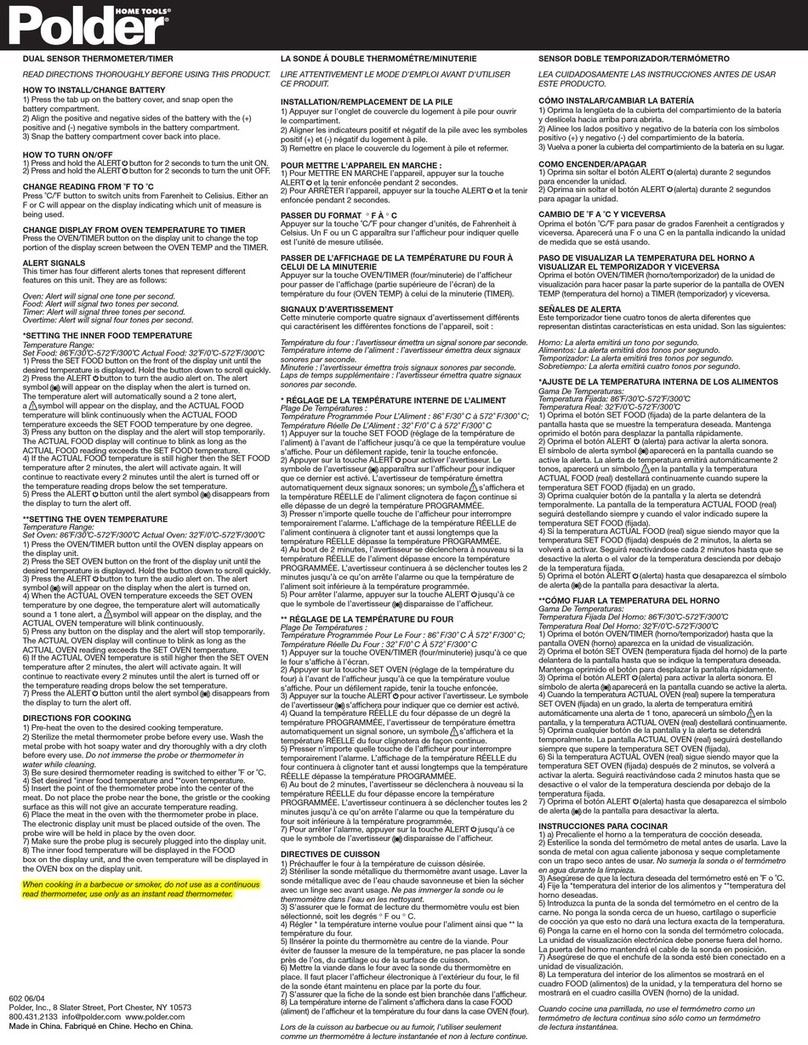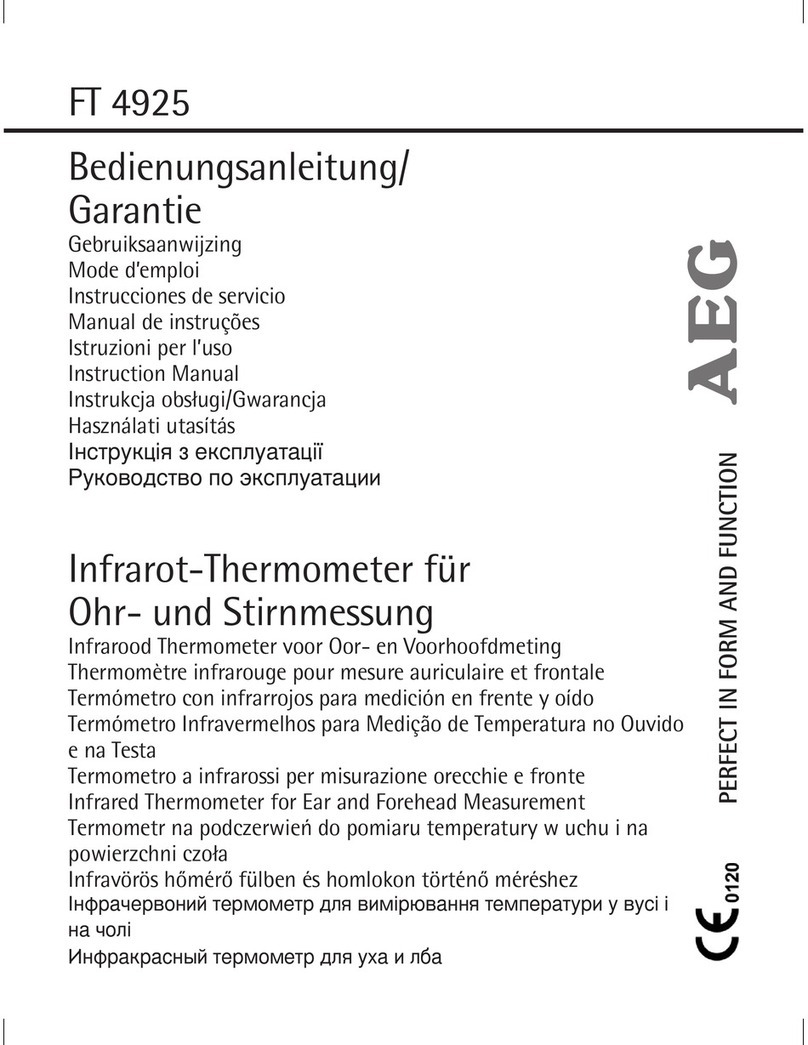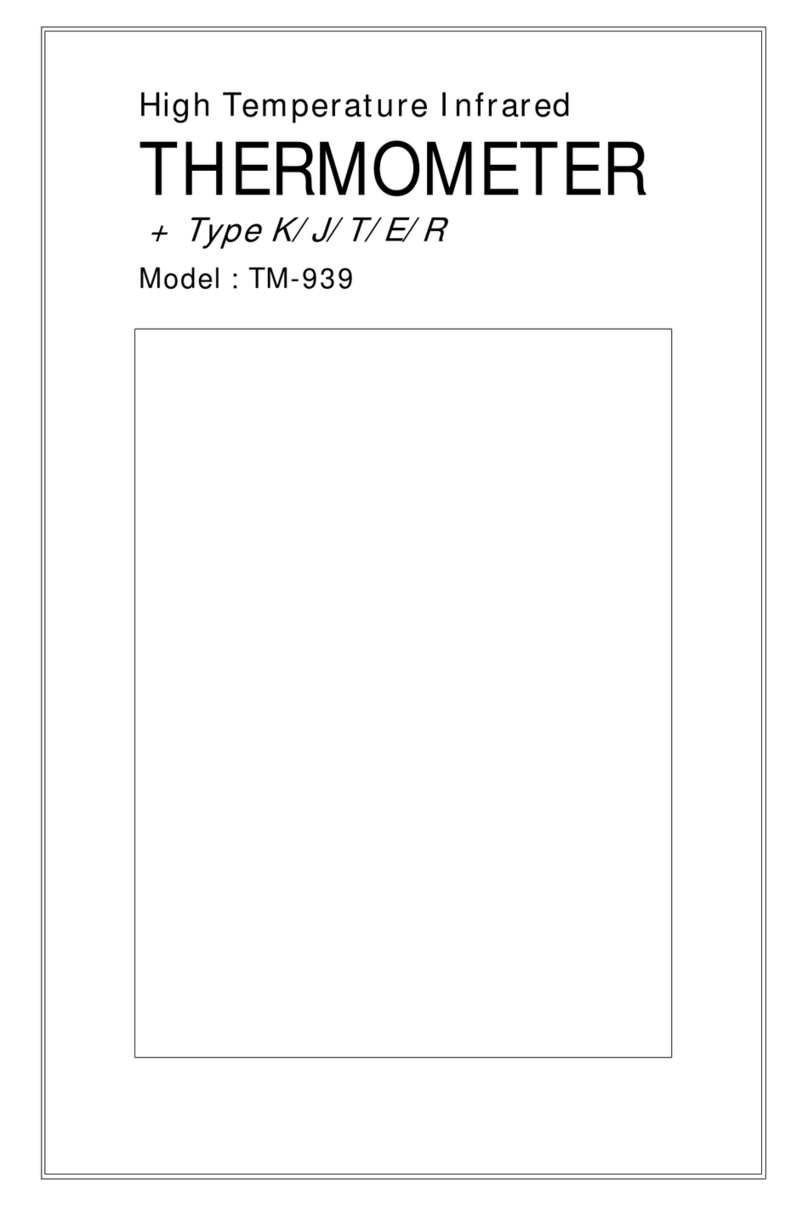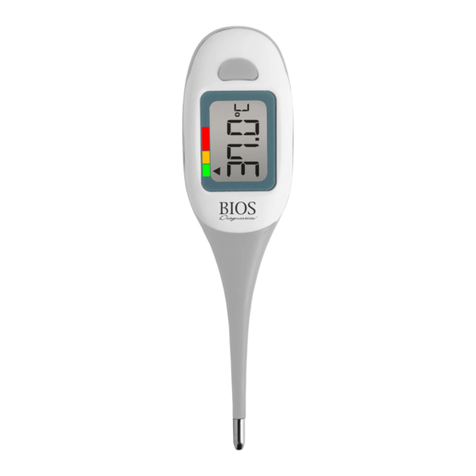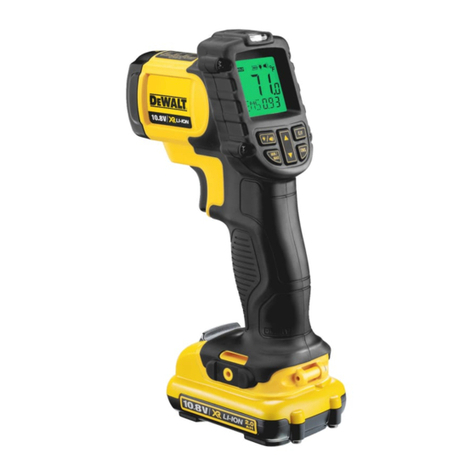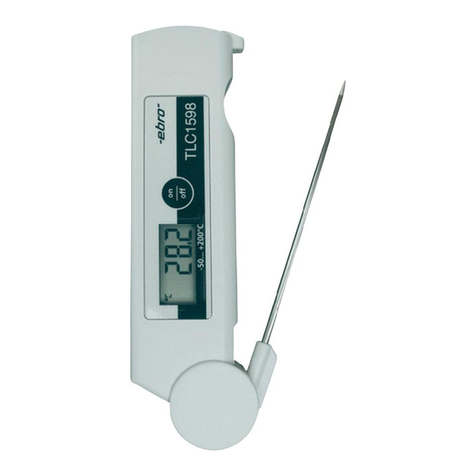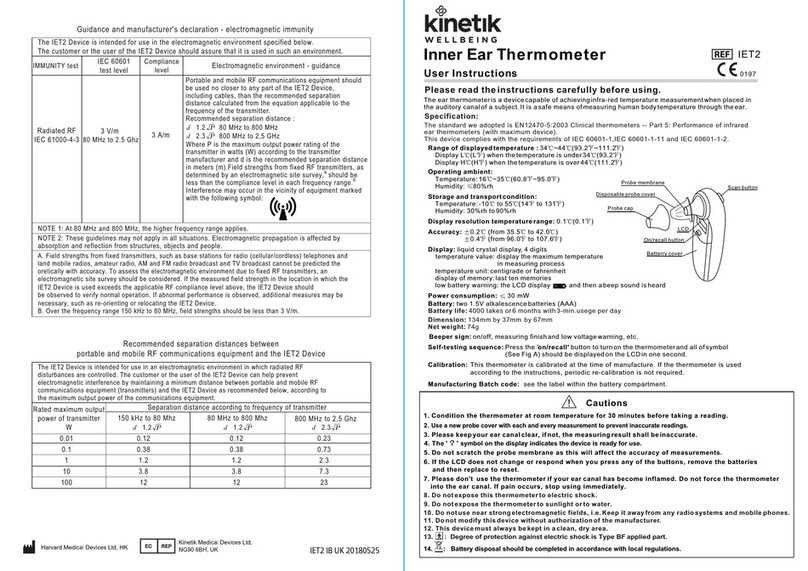GHM Delta OHM HD2307.0 User manual

Operating manual
RTD Thermometer
HD2
307.0
www.deltaohm.com
Companies / Brands of GHM
English
Keep for future reference.

HD2307 - 2 - V1.7
CONTENTS
GENERAL CHARACTERISTICS............................................................................................................................3
DESCRIPTION OF THE FUNCTIONS ...............................................................................................................6
THE PROGRAMMING MENU ................................................................................................................................9
PROBES AND MEASUREMENTS.......................................................................................................................10
TEMPERATURE MEASUREMENT................................................................................................................................... 10
CALIBRATION OF THE PROBE...................................................................................................................................... 10
CALIBRATION SEQUENCE –INSTRUMENT ON LINE WITH THE PROBE(S):.............................................................. 11
CONNECTING THE TP47 CONNECTOR FOR THE 3AND 4WIRE PT100 AND 2OR 4-WIRE PT1000
PROBES:....................................................................................................................................................................... 12
DIRECT CONNECTION OF 4WIRE PT100 SENSORS.......................................................................................................... 14
WARNINGS AND OPERATING INSTRUCTIONS .....................................................................................15
INSTRUMENT SIGNALS AND FAULTS .........................................................................................................16
INSTRUMENT STORAGE......................................................................................................................................16
LOW BATTERY WARNING AND BATTERY REPLACEMENT ...............................................................17
WARNING ABOUT BATTERY USE................................................................................................................................. 17
NOTES ABOUT WORKING AND OPERATIVE SAFETY..........................................................................18
INSTRUMENT TECHNICAL CHARACTERISTICS .....................................................................................19
TECHNICAL INFORMATION ON THE RTD THERMOMETER......................................................................................... 19
TECHNICAL DATA OF PROBES AND MODULES IN LINE WITH THE INSTRUMENT....................................................... 20
TEMPERATURE PROBES PT100 SENSOR USING SICRAM MODULE ...................................................................20
Pt100/Pt1000 probes with TP47 connector without SICRAM module ..........................................20
ORDERING CODES .................................................................................................................................................21

HD2307 - 3 - V1.7
GENERAL CHARACTERISTICS
The RTD Thermometer Model HD2307.0 is a portable instrument that measures the
temperature.
It is fitted with a large LCD display for excellent visualization of the measured data.
The RTD Thermometer Model HD2307.0 measures the temperature using immersion,
penetration, contact or air probes. In this case, the sensor can be a 3 or 4 wire Pt100,
or 2 or 4 wire Pt1000.
The probes are fitted with the automatic detection module, with the factory calibration
settings already being memorized inside.
The units of measurement are the following:
1. °C Celsius degrees
2. °F Fahrenheit degrees
Using the Max, Min and Avg function of this instrument respectively obtains the
maximum, minimum or average values.
Other available functions are:
•the relative measurement REL;
•the HOLD function;
•the automatic turning off which can also be disabled.

HD2307 - 4 - V1.7
RTD Thermometer
HD2307.0

HD2307 - 5 - V1.7
HD2307.0
1. Input for probes, 8-pole DIN45326 connector.
2. Battery symbol: displays the battery charge level.
3. Function indicators.
4. Secondary display line.
5. DATA/ENTER key: during normal operation displays the maximum (MAX), the
minimum (MIN) and the average (AVG) of current measurements; in the menu,
confirms the current selection.
6. CLR/ESC key: during normal operation resets the maximum, the minimum and
the average of current measurements; in the menu, it resets the value set with the
arrows.
7. HOLD/key: freezes the measurement during normal operation; in the menu,
increases the current value.
8. UNIT/MENU key: it allows selection of the unit of measurement; when pressed
together with the DATA key, it allows to open the menu.
9. REL/key: during normal operation enables the relative measurement (displays
the difference between the current value and the logged value when the key is
pressed); in the menu, decreases the current value
10.ON-OFF/AUTO-OFF key: turns the instrument on and off; when pressed together
with the HOLD key, disables the AutoPowerOff function.
11.MAX (maximum value), MIN (minimum value) and AVG (average value) symbols.
12.Main display line.
13.Line for symbols and comments.

HD2307 - 6 - V1.7
DESCRIPTION OF THE FUNCTIONS
The keyboard of the RTD Thermometer Model HD2307.0 is composed of double-
function keys. The function on the key is the "main function", while the one above the
key is the "secondary function".
When the instrument is in standard measurement mode, the main function is active.
In the menu, the secondary function is enabled; press the DATA+UNIT keys together
to open the menu.
The pressing of a key is accompanied by a short confirmation "beep": a longer "beep"
sounds if the wrong key is pressed. Each key specific function is described in detail
below.
This key has two functions:
•ON/OFF: press this key to turn the instrument on and off.
The turning on enables all display segments for a few seconds, starts an Auto-test
including the detection of the probe connected to the input, and sets the instrument
ready for normal measurement.
•AUTO/OFF: the AutoPowerOff function can be disabled by simultaneously
pressing this key and the "HOLD" key when turning the instrument on.
During turning on, should no probes be connected, the "NO_PRBE_SER_NUM"
message is displayed in the line for symbols for a few seconds, and in the main line a
series of dashes appears while the "ERR" message replaces the temperature.
When the probe is inserted into a functioning instrument, the "NEW_PROB_DET"
(New probe detected) message appears: as the data are captured upon turning the
instrument on, it is necessary to turn it off and on again.
Caution! Replace the probes when the instrument is off.
ON-OFF and AUTO-OFF

HD2307 - 7 - V1.7
The instrument has an AutoPowerOff function that automatically turns the instrument
off after about 8 minutes if no key is pressed during the intervening time.
Press simultaneously the ON/OFF key and the HOLD key to disable this function.
In this case, remember to turn the instrument off using the ON/OFF key: disabling of
the automatic turning off is shown by the blinking battery symbol.
The DATA key is used for the following functions:
•DATA: during normal measurement, by pressing this key once the maximum
(MAX) value of the measurements captured by the probe connected to the
instrument is displayed, updating it with the acquisition of new samples;
-by pressing this key again the minimum (MIN) value is displayed;
-by pressing this key a third time the average (AVG) value is displayed.
The acquisition frequency is once a second.
The MAX, MIN and AVG values remain in the memory until the instrument is on,
even after exiting the DATA display function. When the instrument is off, the
previously memorized data are cleared. Upon turning on, the instrument
automatically starts memorizing the MAX, MIN and AVG values.
To reset the previous values and start with a new measurement session, press
CLR until the FUNC_CLRD message appears.
•ENTER: once the MENU has been opened with the DATA+UNIT keys, the DATA
key will perform the ENTER function and the MENU can be browsed and the
displayed parameter confirmed.
The CLR key has two functions:
•CLEAR (CLR): allows to reset the maximum (MAX), minimum (MIN) and average
(AVG) value of the captured measurements;
•ESC: once the MENU has been opened with the DATA+UNIT keys, the CLR key
will allow to cancel the parameters set using the and arrows.
The HOLD key is used for the following functions:
•HOLD: by pressing this key the current measurement update is stopped and the
"HOLD" message will appear in the upper left-hand corner of the display. To return
to the current measurement, press the key again.
DATA/ENTER key
HOLD/key
Disabling of the automatic turning off
CLR/ESC key

HD2307 - 8 - V1.7
•: once the MENU has been opened with the DATA+UNIT keys, the key will
allow to increase the value of the selected parameter.
Pressed together with the ON/OFF key, during turn on, the AutoPowerOff function is
disabled (see the description of the ON/OFF key).
The UNIT key is used for the following functions:
•UNIT: by pressing this key the unit of measurement of the main input quantity is
selected: the unit of measurement will appear in the upper part of the display; the
measured value will be displayed in the central line. By repeatedly pressing the
UNIT key, the desired unit of measurement can be selected between the
following:
1. °C Celsius degrees
2. °F Fahrenheit degrees
•MENU: in the menu two items can be set:
1. Probe type
2. User calibration procedure for the temperature probe connected to the
instrument
-the menu is opened by pressing simultaneously DATA+UNIT: the first item of the
instrument programming menu will appear;
-use the and arrows (respectively located above the HOLD and REL keys) to
modify the displayed value;
-press DATA/ENTER to confirm the modification and go onto the next item;
-press CLR/ESC to cancel the modification;
-to exit the menu, press the UNIT/MENU key again.
The "REL" key is used for the following functions:
•REL: it displays the difference between the current value and that measured on
pressing the key. The "REL" message is displayed on the left. To return to the
normal measurement, press the key again.
•: once the MENU has been opened with the DATA+UNIT keys, the key will
allow to decrease the value of the selected parameter.
REL/key
UNIT/MENU key

HD2307 - 9 - V1.7
THE PROGRAMMING MENU
To access to the menu press simultaneously the following keys:
The items to be set are listed in this order:
1. Probe type:the "RTD_PRBE_TYPE" message is displayed in the comment
line. The main line in the center of the display shows the type of probe
connected to the instrument. The following probes can be connected to the
input:
•temperature probes Pt100 complete with SICRAM module
•direct 4-wire Pt100 probes complete with TP47 module
•direct 3-wire Pt100 probes complete with TP47 module
•2 or 4-wire Pt1000 probes complete with TP47 module
Upon turning on the instrument automatically detects the probes fitted with
SICRAM module: the Probe Type menu item is configured as AUTO and cannot
be modified by the user.
Upon turning on the direct 4 wire Pt100, direct 3 wire Pt100, and 2 wire Pt1000
temperature probes display the "NO_PRBE_SER_NUM"( no serial number
of the connected probe) message; in this case the probe type must be
entered manually. Select Probe type using the MENU key and then select the
type of probe with the arrow keys; confirm using ENTER.
•use the and arrows (respectively located above the HOLD and REL keys)
to modify the type of probe;
•press DATA/ENTER to confirm the modification and go onto the next item;
•press CLR/ESC to cancel the modification;
•to exit the menu, press the UNIT/MENU key again.
2. Starting the User calibration procedure: the ">>>_CAL_MODE" message
is displayed in the comment line, and "FACt" is displayed in the main line.
The instrument is provided with the factory ("FACt") calibration. It is also
possible to perform a "USER calibration" ("USEr")of instrument+probe. The
calibration information is saved in the instrument memory and not in the probe.
The same correction is applied to any probe connected to the input: therefore,
the "USER calibration" should only be used with the probe used for calibration
and not with other probes.
•use the and arrows (respectively located above the HOLD and REL
keys) and select USEr, to access the "USER calibration" procedure;
•press DATA/ENTER to confirm the modification;
•the "SEL_MEAS_1/2" message is displayed in the comment line;
•use the and arrows (respectively located above the HOLD and REL
keys) to select "0", "1" or "2" in the main line;
•press DATA/ENTER to confirm the modification;
•press CLR/ESC to cancel the modification;
•to exit the menu, press the UNIT/MENU key again.

HD2307 - 10 - V1.7
PROBES AND MEASUREMENTS
The instrument works with temperature probes fitted with SICRAM module (with a
Platinum Pt100 sensor with 100Ω resistance) or with direct 4 wire Pt100, 3 wire
Pt100, or 2 wire Pt1000 sensor. The excitation current was chosen in order to
minimize the sensor self-heating effects.
The SICRAM module acts as an interface between the sensor on the probe and the
instrument. There is a microprocessor circuit with a permanent memory inside the
module that enables the instrument to recognize the type of probe connected and to
read its calibration information.
The probes with SICRAM module are automatically detected, while the direct probes
must be set up in the Probe type menu item (please see chapter ‘The programming
menu’).
The probe is detected during turn on, and this cannot be performed when the
instrument is already on, therefore if a probe is connected and the
instrument is on, it is necessary to turn it off and on.
TEMPERATURE MEASUREMENT
In all versions the temperature sensor is housed in the end part of the probe.
The response time for the measurement of the temperature in air is greatly reduced if
the air is moving. If the air is still, stir the probe. The response times are longer than
those for liquid measurements.
The temperature measurement by immersion is carried out by inserting the probe in
the liquid for at least 60 mm; the sensor is housed in the end part of the probe.
In the temperature measurement by penetration the probe tip must be inserted to a
depth of at least 60 mm, the sensor is housed in the end part of the probe.
NOTE: when measuring the temperature on frozen blocks it is convenient to use a
mechanical tool to bore a cavity in which to insert the tip probe.
In order to perform a correct contact measurement, the measurement surface must
be even and smooth, and the probe must be perpendicular to the measurement plane.
So as to obtain the correct measurement, the insertion of a drop of oil or
heat-conductive paste between the surface and the probe is useful (do not
use water or solvents). This method also improves the response time.
The °C or °F unit of measurement can be chosen using the UNIT/MENU key.
CALIBRATION OF THE PROBE
To calibrate the probes correctly, a knowledge of and abiding by the physical
phenomena on which the measurement is based is fundamental: this is the reason
why it is recommended to abide by what is reported below carefully, and only to
perform new calibrations if technically proficient and using the suitable equipment.
The sensor is calibrated in the factory and the Callendar Van Dusen
parameters are recorded in the SICRAM module. The probes with direct input

HD2307 - 11 - V1.7
are checked for conformity with class A tolerance according to norm IEC751 -
BS1904 - DIN43760.
The instrument is provided with the FACT (factory) calibration.
The user is also able to perform a USER calibration of instrument+probe.
The calibration information is saved in the instrument memory and not in the probe.
The same correction is applied to any probe connected to the input: therefore, the
"USER calibration" should only be used with the probe used for calibration and not
with other probes.
To pass from the user to the factory calibration and back, proceed as follows:
•press simultaneously UNIT/MENU and DATA/ENTER to open the menu:
•press ENTER until the menu item "CAL_MODE" is selected.
•use the and arrows (respectively located above the HOLD and REL keys) to
select the type of calibration;
•confirm by pressing DATA/ENTER.
CALIBRATION SEQUENCE –INSTRUMENT ON LINE WITH THE PROBE(S):
The calibration can be carried out on one or two points that should differ by at
least 10°C and be included in the probe functioning range.
1. Insert the probe into a thermostatic bath, the temperature of which is precisely
known from a reading taken on a sample reference thermometer. Wait for the
measurement to stabilize.
2. Press contemporarily UNIT/MENU and DATA/ENTER.
3. Press DATA/ENTER.
4. Use the and arrows (respectively located above the HOLD and REL keys) to
select the USER calibration;
5. Confirm with DATA/ENTER.
6. The "SEL_MEAS_1/2" message is displayed in the comment line.
7. Use the and arrows to select "1" (first calibration point).
8. Confirm with DATA/ENTER.
9. The "UP DOWN 1st MEAS" message is displayed in the comment line: the
instrument display shows the measured temperature.
10.Use the and arrows to correct the indicated value until it coincides with the
value measured by the sample reference thermometer.
11.Confirm with DATA/ENTER.
12.To exit the procedure without performing the second point, select "0" and press
ENTER.
13.To calibrate the second point, select the point "2" using the and arrows.
14.Press DATA/ENTER.
15.The "UP DOWN 2nd MEAS" message is displayed in the comment line.
16.Move the probe to the second thermostatic bath and wait for the measurement to
stabilize.
17.The instrument display shows the measured temperature.
18.Use the and arrows to correct the indicated value until it coincides with the
value measured by the sample reference thermometer.
19.Confirm with DATA/ENTER.
20.To exit the procedure, select "0" using the and arrows and press ENTER.
The procedure is now complete.

HD2307 - 12 - V1.7
CONNECTING THE TP47 CONNECTOR FOR THE 3AND 4WIRE PT100 AND 2OR 4-
WIRE PT1000 PROBES:
Where present, extend the telescopic rod to the necessary length paying attention to
the cable so that All probes produced by Delta OHM are provided with a connector.
The Platinum Thermometer Model HD2307.0 also work with direct 3 and 4-wire
Pt100 and 2 or 4-wire Pt1000 probes manufactured by other producers; for the
instrument connection is prescribed the TP47 connector to which the probe's wires
should be welded.
The instructions to connect the Platinum probe to the TP47 module are provided
below.
The TP47 module is supplied complete with fairlead and gasket for 5 mm maximum
diameter cables.
Do the following to open the module and connect a probe:
1. unscrew the fairlead;
2. extract the gasket;
3. remove the label using a cutter;
4. unscrew the ring on the opposite side as illustrated in the figure:
5. open the two module shells: the printed circuit to which the probe must be
connected is housed inside. On the left there are the 1…4 points on which the
sensor wires must be welded. The JP1…JP4 jumpers are in the center of the board.
These must be closed with a tin bead for some type of sensors:
1
2
3
4
Pt100 3 wires
Pt1000
Ni1000
Not Used
Caution! Before welding, pass the probe cable through the fairlead and gasket.

HD2307 - 13 - V1.7
6. Weld the wires as shown in the table:
Sensor
TP47 Board connection
Jumper to close
Pt100 4
wires
4JP4
3JP3
1JP1
2 JP2
Pt100
4 wires
None
Pt100 3
wires
4JP4
3JP3
1JP1
2 JP2
Pt100
3
wires
JP1
Pt1000 2
wires
JP4
4JP3
3
JP1
1JP22
Pt1000
2
wires
JP2
Pt1000 4
wires
JP2
Ensure the welds are clean and perfect.
7. Once the welding operation is complete, close the two shells;
8. Insert the gasket in the module;
9. Screw the fairlead and the ring.
10.At the other end of the module, enter the ring with the O-Ring as indicated in the
picture.
11.Make sure the cable is not twisted while you are screwing the fairlead. Now the
probe is ready.

HD2307 - 14 - V1.7
DIRECT CONNECTION OF 4WIRE PT100 SENSORS
4 wire Pt100 sensors can be soldered
directly to the pins of the flying female
connector without making use of the
TP47 board. The 4 wires of the Pt100
sensors have to be soldered as
indicated in the figure on the left. In
order to use this type of probe it is
necessary to set up the menu item
“Probe Type”.
The P100 probe is recognized upon
turning on the instrument: connect the
probe when the instrument is switched
off and then turn it on.
Sensor
Direct soldering to the connector
Pt100 4
wires
View of the soldering side
of the flying female connector

HD2307 - 15 - V1.7
WARNINGS AND OPERATING INSTRUCTIONS
1. Do not expose the probes to gases or liquids that could corrode the material of the
sensor or the probe itself. Clean the probe carefully after each measurement.
2. Do not bend the probe connectors or force them upward or downward.
3. Do not bend or force the contacts when inserting the probe connector into the
instrument.
4. Do not bend, deform or drop the probes, as this could cause irreparable damage.
5. Always select the most suitable probe for your application.
6. Do not use the temperature probes in presence of corrosive gases or liquids. The
sensor container is made of AISI 316 stainless steel, while the contact probe
container is made from AISI 316 stainless steel plus silver. Avoid contact between
the probe surface and any sticky surface or product that could corrode or damage
it.
7. Above 400°C and below –40°C, avoid violent blows or thermal shocks to Platinum
temperature probes as this could cause irreparable damage.
8. To obtain reliable measurements, temperature variations that are too rapid must
be avoided.
9. Temperature probes for surface measurements (contact probes) must be held
perpendicular against the surface. Apply oil or heat-conductive paste between the
surface and the probe in order to improve contact and reduce reading time.
Whatever you do, do not use water or solvent for this purpose. A contact
measurement is always very hard to perform. It has high levels of uncertainty and
depends on the ability of the operator.
10.Temperature measurements on non-metal surfaces usually require a great deal of
time due to the low heat conductivity of non-metal materials.
11.The sensor is not insulated from its external casing; be very careful not to come
into contact with live parts (above 48V). This could be extremely
dangerous for the instrument as well as for the operator, who could be
electrocuted.
12.Avoid taking measurements in presence of high frequency sources, microwave
ovens or large magnetic fields; results may not be very reliable.
13.Clean the probe carefully after use.
14.The instrument is water resistant and IP67, but should not be immersed in water.
The probe connectors must be fitted with sealing gaskets. Should the instrument
fall into the water, check for any water infiltration. Gently handle the instrument in
such a way as to prevent any water infiltration from the connectors' side.

HD2307 - 16 - V1.7
INSTRUMENT SIGNALS AND FAULTS
The following table lists all error indications and information displayed by the
instrument and supplied to the user in different operating situations:
Display indications
Explanation
>>> CAL_MODE
Calibration mode
RTD_PRBE_TYPE
Type of probe connected
1ST_MEAS UP DOWN
Correct the first point using the arrows
/
2ND_MEAS UP DOWN
Correct the second point using the arrows
/
BATT TOO LOW
CHNG NOW
Indication of insufficient battery charge appearing on turning on.
The instrument issues a long beep and turns off. Replace the
batteries.
CAL
LOST
Program error: it appears after turning on for a few seconds.
Contact the instrument's supplier.
CAL FACT
Factory calibration
CAL USER
User calibration
ERR
This appears if the probe has already been detected by the
instrument, but is disconnected. At the same time an
intermittent beep is issued.
FUNC CLRD
Max, min and average values cleared
NEW PROBE DET This message appears when a probe is inserted into a functioning
instrument. Turn the instrument off and then back on again.
NO_PRBE_ SER_NUM
The connected probe's serial number is absent
OVER or UNDR
Measurement overflow: indicates that the probe is measuring
a value exceeding the measuring range.
PLS_EXIT >>> FUNC
RES_FOR_FACT ONLY
Please exit using ESC >>> function reserved to factory
calibration
PRBE_SER #### ####
Serial number #### #### of the connected probe
PROB
ERR
A probe with SICRAM module has been inserted when not
admissible for that specific instrument.
PROB COMM LOST
This appears if the probe has already been detected by the
instrument, but is disconnected. At the same time an
intermittent beep is issued.
SEL MEAS 1/2
Select measurement 1 or 2
SYS
ERR
#
Instrument management program error. Contact the
instrument's supplier and communicate the numeric code #
reported by the display.
INSTRUMENT STORAGE
Instrument storage conditions:
•Temperature: -25…+65°C.
•Humidity: less than 90%RH without condensation.
•Do not store the instrument in places where:
•humidity is high;
•the instrument may be exposed to direct sunlight;
•the instrument may be exposed to a source of high temperature;
•the instrument may be exposed to strong vibrations;
•the instrument may be exposed to steam, salt or any corrosive gas.
The instrument case is made of ABS plastic: do not use any incompatible solvent for
cleaning.

HD2307 - 17 - V1.7
LOW BATTERY WARNING AND BATTERY REPLACEMENT
The battery symbol
on the display constantly shows the battery charge status. To the extent that batteries
have discharged, the symbol "empties". When the charge decreases still further it
starts blinking.
In this case, batteries should be replaced as soon as possible.
If you continue to use it, the instrument can no longer ensure correct measurement.
The memory data are maintained.
If the battery charge level is insufficient, the following message appears
when you turn the instrument on:
BATT TOO LOW
CHNG NOW
The instrument issues a long beep and turns off. In this case, replace the
batteries in order to turn the instrument back on.
To replace the batteries, proceed as follows:
1. switch the instrument off;
2. unscrew the battery cover counter clockwise;
3. replace the batteries (3 1.5V alkaline batteries - type AA);
4. screw the cover on clockwise.
Malfunctioning upon turning on after battery replacement
After replacing the batteries, the instrument may not restart correctly; in this case,
repeat the operation.
After disconnecting the batteries, wait a few minutes in order to allow circuit
condensers to discharge completely; then reinsert the batteries.
WARNING ABOUT BATTERY USE
•Batteries should be removed when the instrument is not used for an extended
time.
•Flat batteries must be replaced immediately.
•Avoid batteries leaking.
•Always use good quality leakproof alkaline batteries. Sometimes on the market,
it is possible to find new batteries with an insufficient charge capacity.

HD2307 - 18 - V1.7
NOTES ABOUT WORKING AND OPERATIVE SAFETY
Authorized use
The technical specifications as given in chapter TECHNICAL CHARACTERISTICS must
be observed. Only the operation and running of the measuring instrument according
to the instructions given in this operating manual is authorized. Any other use is
considered unauthorized.
General safety instructions
This measuring system is constructed and tested in compliance with the EN 61010-1
safety regulations for electronic measuring instruments. It left the factory in a safe
and secure technical condition.
The smooth functioning and operational safety of the measuring system can only be
guaranteed if the generally applicable safety measures and the specific safety
instructions in this operating manual are followed during operation.
The smooth functioning and operational safety of the instrument can only be
guaranteed under the environmental and electrical operating conditions that are in
specified in chapter TECHNICAL CHARACTERISTICS.
Do not use or store the product in places such as listed below:
•Rapid changes in ambient temperature which may cause condensation.
•Corrosive or inflammable gases.
•Direct vibration or shock to the instrument.
•Excessive induction noise, static electricity, magnetic fields or noise.
If the measuring system was transported from a cold environment to a warm
environment, the formation of condensate can impair the functioning of the measuring
system. In this event, wait until the temperature of the measuring system reaches
room temperature before putting the measuring system back into operation.
Obligations of the purchaser
The purchaser of this measuring system must ensure that the following laws and
guidelines are observed when using dangerous substances:
EEC directives for protective labour legislation
National protective labour legislation
Safety regulations

HD2307 - 19 - V1.7
INSTRUMENT TECHNICAL CHARACTERISTICS
TECHNICAL INFORMATION ON THE RTD THERMOMETER
Instrument
Dimensions (Length x Width x Height) 140 x 88 x 38 mm
Weight 160 g (complete with batteries)
Material ABS
Display 2x4½ digits plus symbols
Visible area: 52 x 42 mm
Operating conditions
Operating temperature -5…+50°C
Warehouse temperature -25…+65°C
Working relative humidity 0…90% RH without condensation
Protection degree IP67
Power
Batteries 3 1.5V type AA batteries
Autonomy 200 hours with 1800mAh alkaline
batteries
Power absorbed with instrument off < 20 µA
Connections
Input for probes 8-pole male DIN45326 connector
Unit of Measurement °C - °F;
Measurement of temperature by Instrument
Pt100 measurement range -200…+650°C
Pt1000 measurement range -200…+650°C
Resolution 0.1°C
Accuracy ±0.05°C
Drift after 1 year 0.1°C/year

HD2307 - 20 - V1.7
TECHNICAL DATA OF PROBES AND MODULES IN LINE WITH THE INSTRUMENT
TEMPERATURE PROBES PT100 SENSOR USING SICRAM MODULE
Model Type
Application
range
Accuracy
TP472I Immersion
-
196°C…+500°C
±0.1°C (@ 0 °C)
±0.2°C (-50 °C ≤ t ≤
250 °C)
±0.3°C (t < -50 °C; t
> 250 °C)
TP472I.O Immersion -50°C…+300°C
TP473P.I Penetration -50°C…+400°C
TP473P.O Penetration -50°C…+300°C
TP474C.O Contact -50°C…+300°C
TP475A.O Air -50°C…+250°C
TP472I.5 Immersion -50°C…+400°C
TP472I.10 Immersion -50°C…+400°C
TP49A.I Immersion -70°C…+250°C
TP49AC.I Contact -70°C…+250°C
TP49AP.I Penetration -70°C…+250°C
TP875.I
Globe-thermometer
Ø 150 mm
-30°C…+120°C
TP876.I
Globe-thermometer
Ø 50 mm
-30°C…+120°C
TP87.O Immersion -50°C…+200°C
Common characteristics
Resolution 0.01°C in the range ±199.99°C,
0.1°C in the remaining field
Temperature drift @ 20°C 0.003%/°C
Pt100/Pt1000 probes with TP47 connector without SICRAM module
Model
Type
Application range
Accuracy
TP47.100.O
Pt100 4 wires
-50…+250°C
Class A
TP47.1000.O
Pt1000 4 wires
-50…+250°C
Class A
TP87.100.O
Pt100 4 wires
-50…+200°C
Class A
TP87.1000.O
Pt1000 4 wires
-50…+200°C
Class A
Common characteristics
Resolution 0.01°C in the range ±199.99°C,
0.1°C in the remaining field
Temperature drift @ 20°C Pt100 0.003%/°C
Pt1000 0.005%/°C
Table of contents
Other GHM Thermometer manuals

GHM
GHM GREISINGER G 1730 User manual
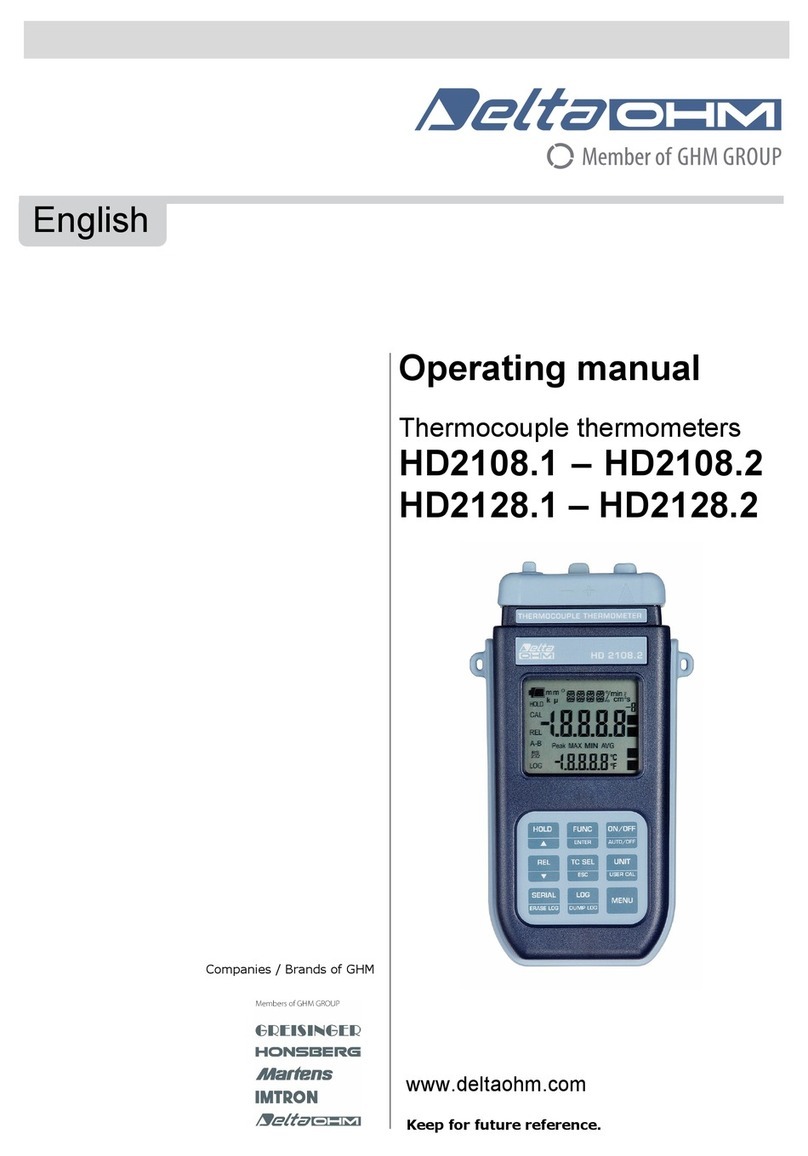
GHM
GHM Delta OHM HD2108.1 User manual
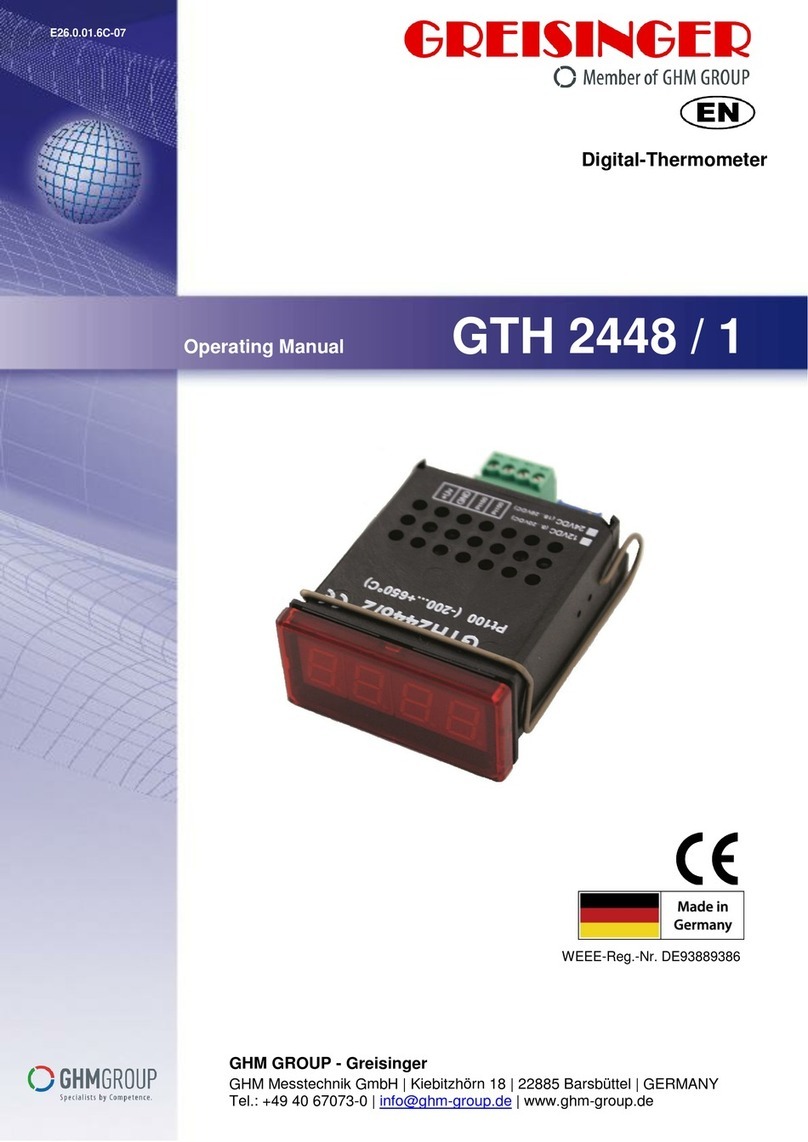
GHM
GHM GREISINGER GTH 2448 / 1 User manual
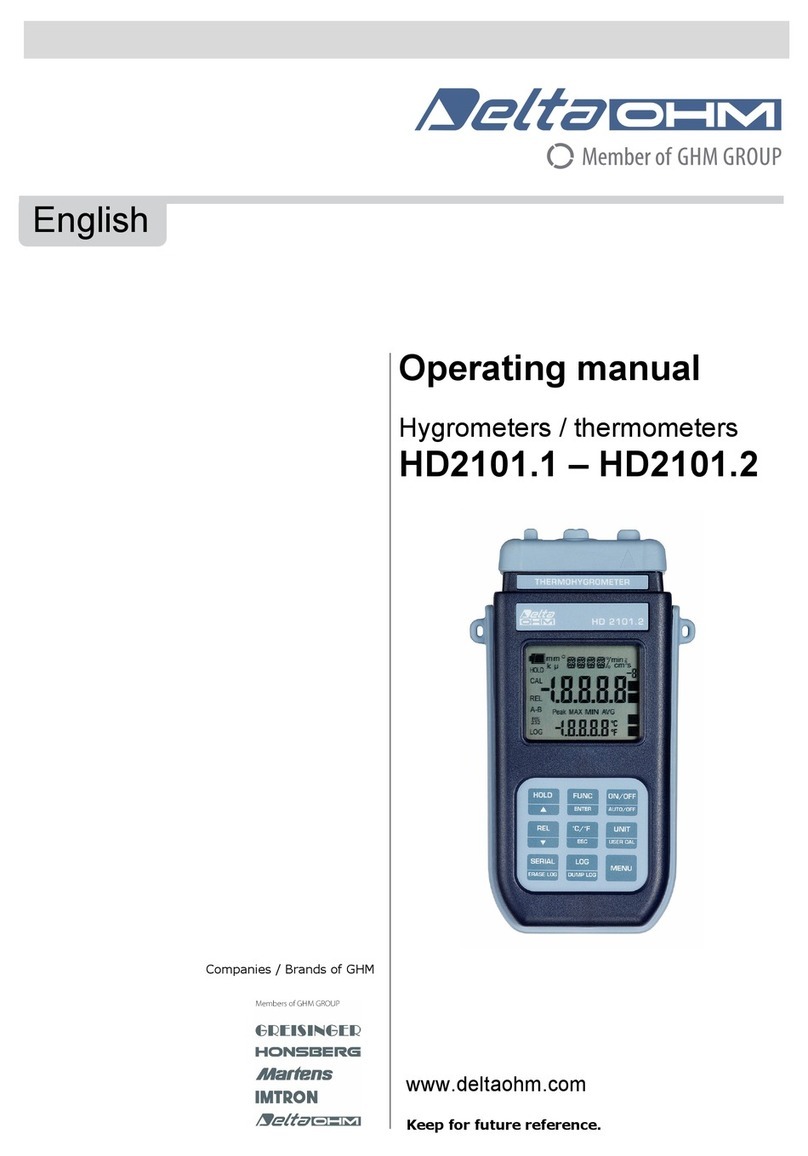
GHM
GHM Delta OHM HD2101.1 User manual
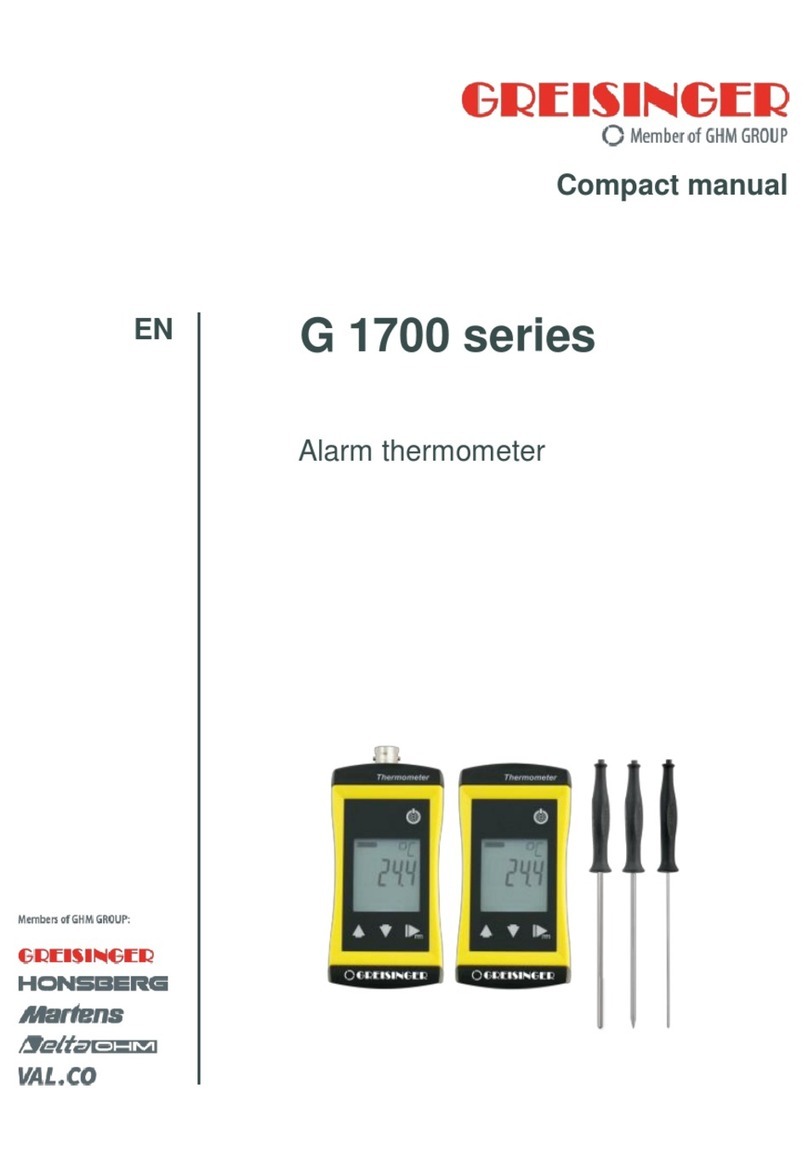
GHM
GHM GREISINGER G 1700 Series Installation instructions

GHM
GHM GREISINGER GTH 1150 User manual

GHM
GHM Delta OHM HD2328.0 User manual

GHM
GHM Greisinger GTH 2448/2 User manual
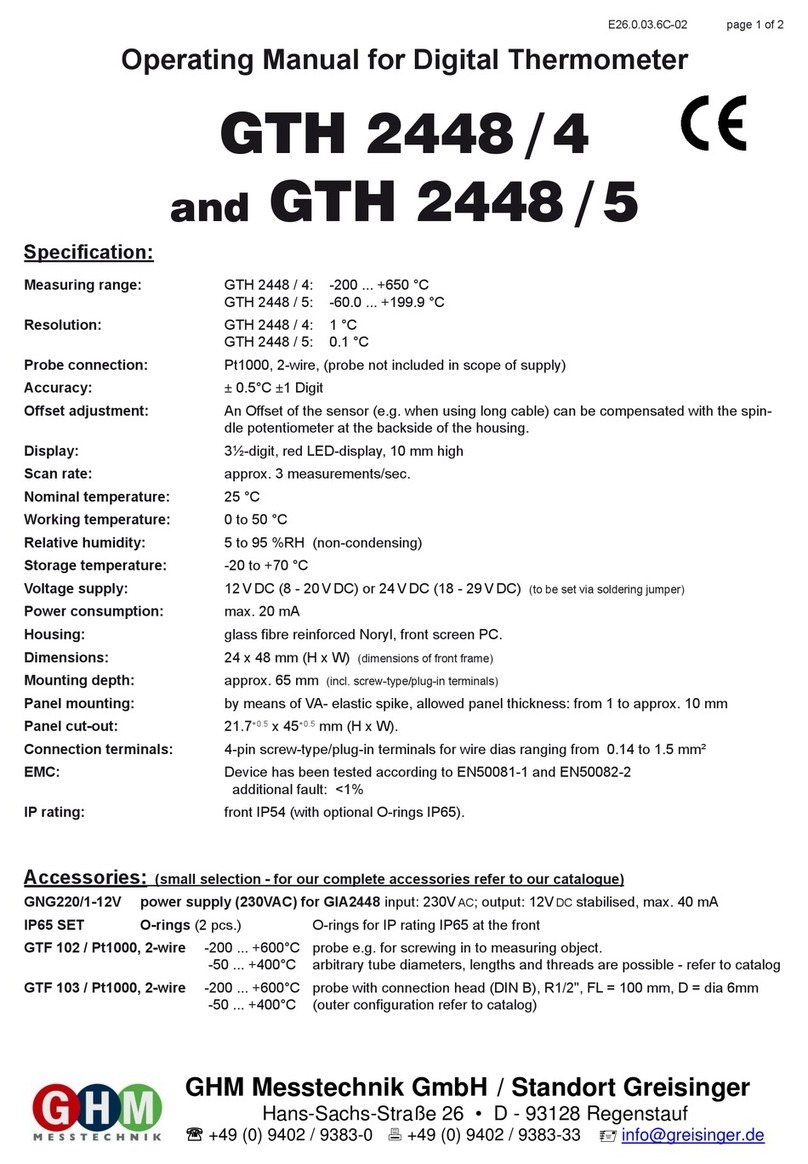
GHM
GHM GTH 2448/4 User manual
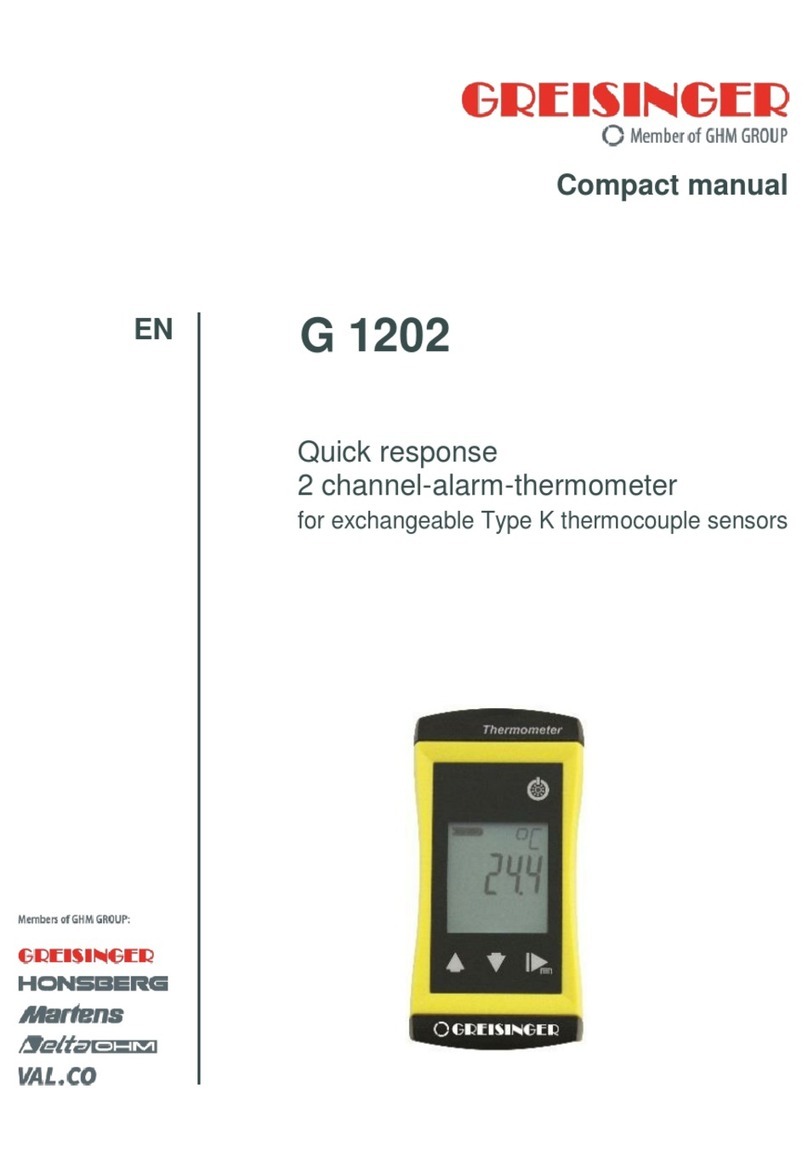
GHM
GHM GREISINGER G 1202 Installation instructions


